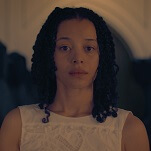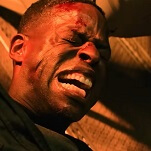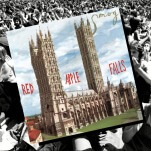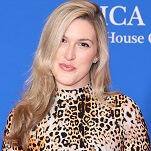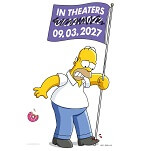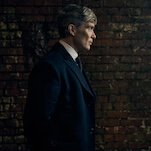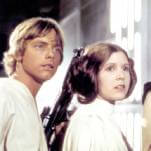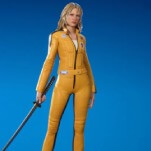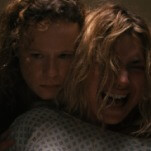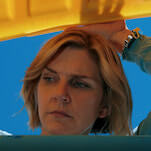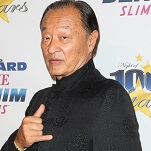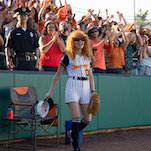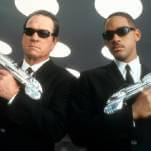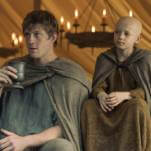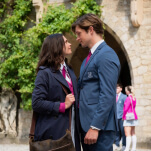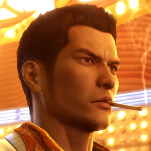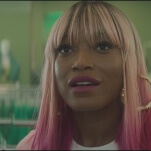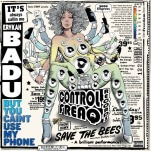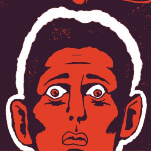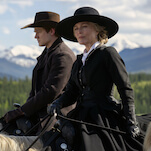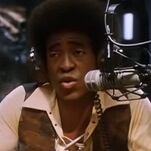One of the first images in Woman Of The Hour, Anna Kendrick’s directorial debut, is actually a shot within a shot. A young woman poses amidst the Wyoming landscape, a spark of white linen against the beige, rocky backdrop. She poses, her arms hanging, gazing into the camera as she tearfully divulges her backstory. This is one of Rodney Alcala’s (Daniel Zovatto in the film) many victims, vulnerable and pretty and desperate to be seen. As Alcala approaches slowly, camera aloft, listening to her explain the circumstances of her recent breakup, a weighty awareness settles across viewers: this will be the final record of her life—whatever remains will be equal part evidence for the deceased and trophy for the killer.
Based on the real record of serial killer Rodney Alcala’s appearance on the game show The Dating Game, Kendrick’s film endeavors to document as many of Alcala’s victims as possible, weaving them throughout the main storyline. While Cheryl Bradshaw (Anna Kendrick, lending the main character her brand of plucky heroine) is the film’s focus, she acts as a conduit for other women’s stories. It is almost immediately apparent that Cheryl isn’t embarking upon The Dating Game with romantic intentions, rather it is presented as a necessary life raft for her flailing acting career. Cheryl fires off questions, parsing through the three anonymous bachelors’ answers (which range from boring to cloying to misogynistic).
Everything is manufactured, a way for the public to characterize and define romantic chemistry, to perceive and digest women, but the questions Kendrick and writer Ian McDonald are concerned with remain the same from that first scene: When does it become violently real? When does perception bleed into action? Or as The Dating Game’s makeup person observes: “The question beneath the question remains the same: which of you are going to hurt me?”
Covering events from the late ‘70s, Woman Of The Hour is somewhat undermined by the digitized, overly saturated images that persist through Netflix period films (think the sepia-toned flashback sequences of The Haunting Of Hill House). But this doesn’t impede Kendrick from carving out important frames with a sculpturer’s precision. She never lingers on the rape and murder Alcala’s victims suffered, but she doesn’t avoid it either. We may only see a woman crawl through her unpacked apartment from an overhead window with Alcala in hot pursuit, or a woman’s wriggling torso dragged through the dirt towards her captor, but all of it is painstakingly framed, sharpened in its briefness.
One of the most striking frames comes in the final sequence, when one of his victims, Amy (Autumn Best), has woken up in the desert, disoriented with bruises dappling her face. Suddenly the camera pulls back to a wide shot, where her torso and face are hidden by a boulder, but her bare legs are visible. The camera holds long enough for audiences to see that her trousers are pushed down, and her ankles are bound. It is a startling reorientation, calculated to drag the audience from shock to pity to disgust to fear, all the while Amy’s face is hidden—she’s not a person, just another case to go unacknowledged by law enforcement.
Woman Of The Hour is an ambitious first film, and Kendrick is determined to do more than just gesture towards the magnitude of misogyny. Cheryl’s final showdown with Alcala is built around the violence that is sucked into a patriarchal vortex, imperceptible except in the moment it occurs. Following their unnerving first date, Cheryl speed walks away from him in an unlit parking lot; despite their firm goodbye Alcala inches forward from the edge of the screen, keeping pace with her even as the camera zooms in. When she reaches her car, he slaps a hand on her door before a group of hapless men pour out from the studio next door. The moment is broken. Nothing happened, yet everything changed.
This is a self-assured take on a story that stretches far, wide, and deep. Alcala’s victims were not just that; they were all women killed by violent impulses they hadn’t been taught to name. Woman Of The Hour is impressive in its willingness to tackle that question: “Which of you will hurt me?” The response is resounding silence, the kind that implicates every man.
Director: Anna Kendrick
Writer: Ian McDonald
Starring: Anna Kendrick, Daniel Zavatto, Autumn Best
Release Date: October 18, 2024 (Netflix)



